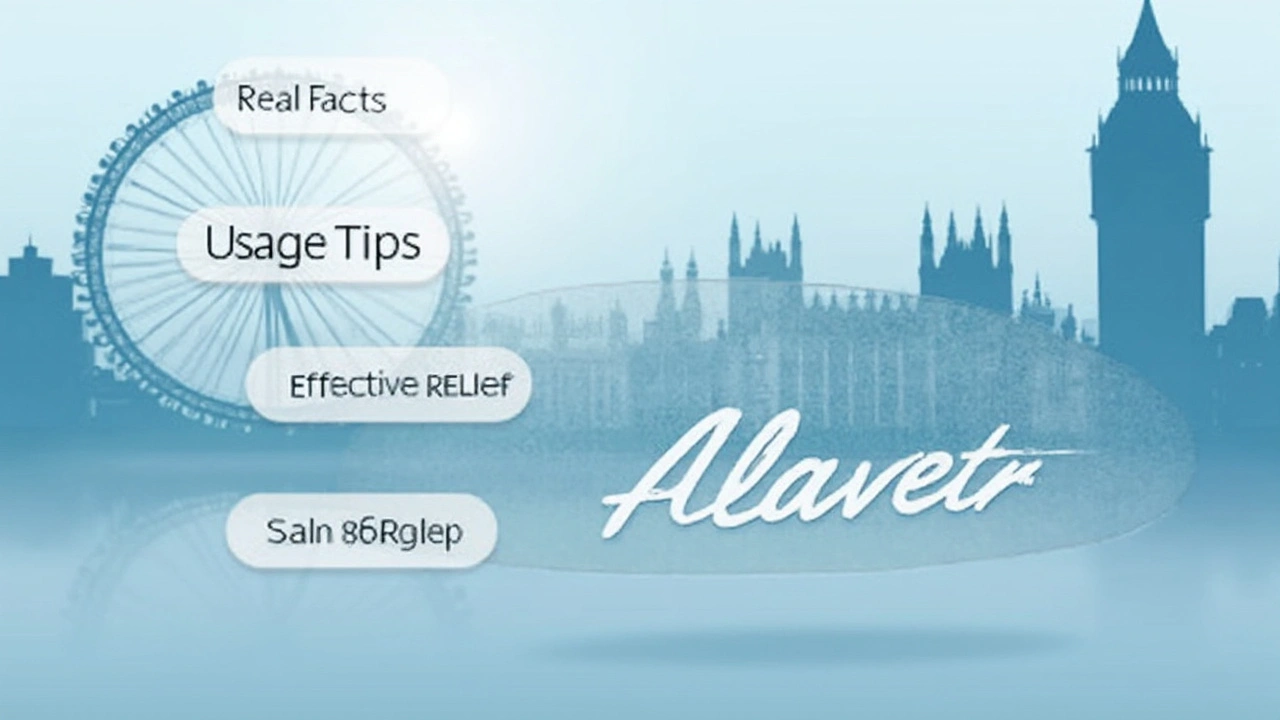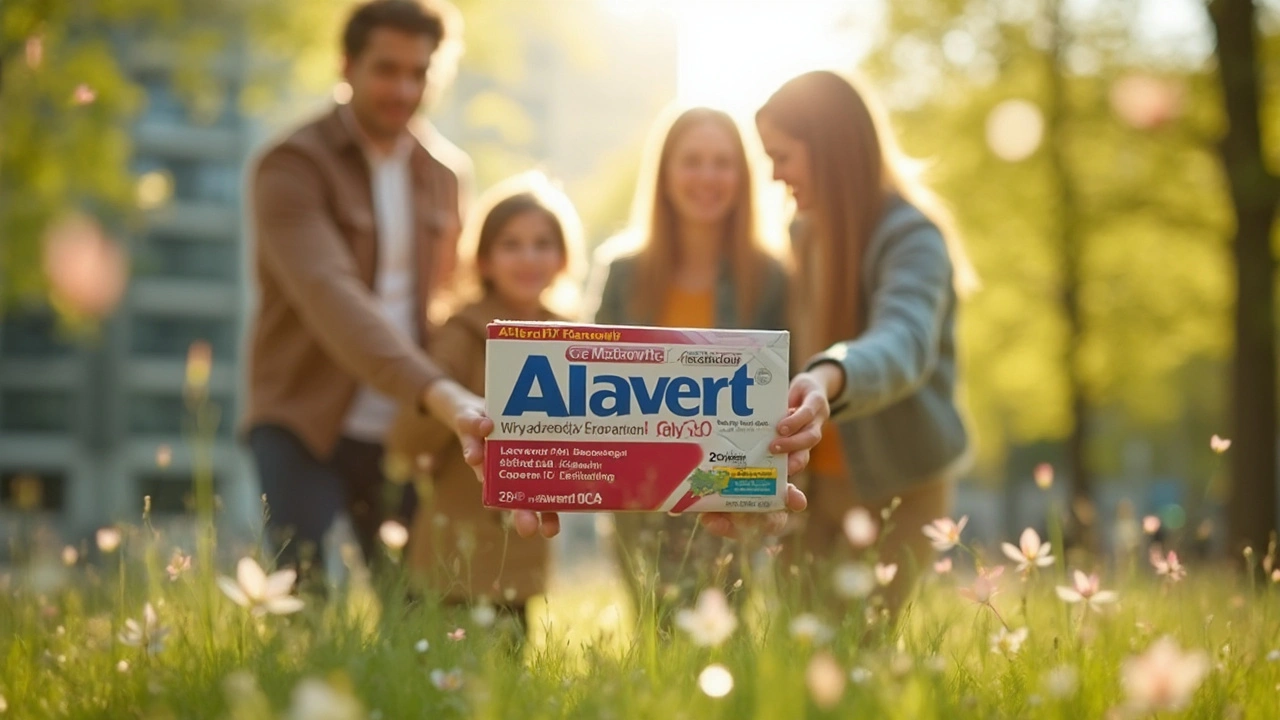Spring teases with its pretty blossoms, but for millions, pollen makes those petals feel less like beauty and more like a sneeze-filled nightmare. I’m one of those people who can gleefully walk the dog one minute, then spend the afternoon itching my nose and reheating the kettle. Antihistamines have become a lifesaver—so let’s really talk about Alavert, a medicine that’s probably sitting in your medicine cabinet right now or catching your eye at the drugstore.
What Is Alavert and How Does It Work?
Alavert is actually the brand name for loratadine, a non-drowsy antihistamine that fights those pesky allergy symptoms like sneezing, watery eyes, and that tickly, scratchy throat you can’t seem to shake after mowing the lawn or dusting the attic. So, what actually happens inside your body? Your immune system spots everyday things like pollen, pet dander, or dust and decides to freak out, even though they’re pretty harmless for most people. It dumps out histamine, which causes your nose to run and your eyes to get red and irritated. That’s where Alavert steps in and puts histamine in timeout, basically calming the chaos so you feel human again.
Loratadine kicked off its life as a prescription drug in Europe back in 1988 and landed in the U.S. in 1993. It joined the over-the-counter family in 2002, making relief just an aisle away, no prescription walk required. People love Alavert because it comes in dissolve-in-your-mouth tablets, which is ideal if you’re tired of swallowing pills, hate the taste of medicine, or you’re on the go without a water bottle. The tablets are sweetened with mannitol, which means they dissolve fast without chalkiness. They don’t contain any dye either, so allergy sufferers who are also wary of odd colorants tend to pick Alavert over other options.
Now, here’s a fact that always surprises: Alavert starts working in about an hour for most people and sticks around for nearly 24 hours. That means one tablet in the morning can get you through meetings, playdates, and even that spontaneous walk in the park. But it’s not a fast-acting rescue for sudden, severe allergic reactions like peanuts—leave that to an epinephrine injection and emergency care. Still, for typical hay fever, it’s pretty reliable stuff.
If you ever wondered why you might see Alavert and Claritin on the shelf together, you’re not imagining things. Both use loratadine as their active ingredient. The difference is in the packaging and sometimes the inactive ingredients, sweeteners, or flavors. Some folks just prefer Alavert’s quick-dissolve formula; my partner Gareth sticks with it because he can take one before work without stopping for a glass of water. These little details matter more than you’d think, especially if you’re bustling through a busy day or corralling kids with allergies.
Another bonus—Alavert is less likely to make you sleepy than older antihistamines like diphenhydramine (the one in Benadryl). You keep your wits about you for driving, studying, and, yes, even late-night Netflix binging without nodding off mid-episode. That’s why lots of teachers, drivers, and anyone who can’t risk drowsiness prefer this medicine for routine use.
Pregnant or breastfeeding? Here’s what’s known: loratadine has a pretty decent safety record, but you always want to double-check with your doctor or pharmacist before popping that tablet just to be careful. Loratadine barely shows up in breast milk and isn’t shown to cause major harm in pregnancy, but the advice stays: always double-check for reassurance.
Here’s a quick at-a-glance breakdown of what Alavert does and doesn’t do:
| Feature | Alavert |
|---|---|
| Active Ingredient | Loratadine 10mg |
| Form | Orally disintegrating tablet, chewable, syrup |
| Onset Time | 1 hour |
| Duration | Up to 24 hours |
| Drowsy Side Effects | Rare |
| Safe for Kids | Yes, age 6+ (ask pediatrician for younger) |
| Main Use | Hay fever, hives, allergy symptoms |
What about its relationship with food or drinks? You can safely take Alavert with or without food. But, if you have a rare metabolic disorder (like phenylketonuria), check the ingredients: some dissolvable versions use artificial sweeteners you’ll want to avoid. Always read that label before popping a new medicine.

When Should You Use Alavert? Dosage, Tips & Precautions
So, when is Alavert the best pick? People grab it for seasonal allergies (think spring/fall pollen), indoor allergies from dust or pet hair, and sometimes, itchy skin hives. Here’s how most use it:
- Adults and kids ages 6 and up: 10 mg once every 24 hours
- No need to split the dose—taking more doesn’t make it work better
- For younger kids (ages 2-5), talk to the pediatrician first since dosing is lower and might need extra care
What gets tricky is when you’re already taking other meds. Loratadine is generally chill—there are few interactions, but it does go through your liver, just like other drugs. If you’re using certain antibiotics, antifungals, or even grapefruit juice (surprise), these can change how loratadine leaves your system and might lead to higher levels of the drug. With those, you could get headaches or feel jittery. No one wants that while dealing with allergies. Your pharmacist can check your prescriptions for overlap in two minutes flat.
Let’s knock out some myths: Nope, you don’t have to “build up” Alavert in your system. It works the first time you use it, even if it’s only mid-season. It doesn’t prevent allergies from starting, but it can soften the blow if you start a day or two before your worst allergy season hits. I start mine around April when the trees kick in; Gareth waits until his eyes water. Both of us survive pollen bombs in our own ways.
People often ask if you can double up on Alavert if your symptoms don’t budge. Please don’t. More isn’t better—it just increases your chances of getting headaches, a fast heartbeat, or a dry mouth. If one tablet a day isn’t enough, it’s smarter to check if you’ve got something else going on or if maybe you need an additional nasal spray, not an overdose of loratadine.
A cool tip: Since Alavert dissolves in your mouth, you can stash a few in your work bag, your car, or even a travel kit. They’re almost weightless, kinder to folks who travel a lot, and you don’t have to worry about water or swallowing huge tablets on a bumpy flight.
Wondering about long-term use? Several studies followed folks for months on daily loratadine, finding it stayed safe and effective the whole time. Your body doesn’t really “get used” to it, and the allergy relief doesn’t fade off unless something else changes in your environment or your health.
Now, side effects—most people find Alavert super gentle, but a small number get mild headaches, tiredness, or dry mouth. Usually, these fade as your body gets used to it, but if you’re suddenly super drowsy or your heartbeat feels weird, just stop and check in with your doctor. Also, if you have liver problems, ask your doctor before using any antihistamine. Your liver breaks down loratadine, so you want to be sure it isn’t strained.
Here’s a little checklist before you buy:
- Do you need dye-free or artificial sweetener-free versions?
- Are you already taking allergy medications?
- Is your child under 6 or have any health conditions?
- Are you pregnant, breastfeeding, or planning to be?
Keeping this in your back pocket can help you avoid surprise reactions at the worst time (like before a big meeting or during vacation). Don’t forget: while Alavert relieves most allergy symptoms, it doesn’t fix stuffy noses as magically as a decongestant. For stubborn congestion, you may need a separate medicine, but always check if it’s safe to combine them.

Comparisons, Shopping Tips & Common Questions About Alavert
Standing in the allergy aisle can make your head spin—Alavert, Claritin, Zyrtec, Allegra. What’s really different? Here’s a handy table to clear up the confusion:
| Product | Active Ingredient | Typical Drowsiness | Onset of Relief | Duration |
|---|---|---|---|---|
| Alavert/Claritin | Loratadine 10mg | Rare | 1-3 hours | Up to 24 hours |
| Zyrtec | Cetirizine 10mg | Occasional | 1 hour | Up to 24 hours |
| Allegra | Fexofenadine 60-180mg | Very rare | 1-2 hours | Up to 24 hours |
| Benadryl | Diphenhydramine 25-50mg | Very common | 15-30 min | 4-6 hours |
Alavert is your go-to for daily allergy relief, especially when you need to stay alert. Zyrtec packs a slightly stronger punch for itchy skin but can make you sleepy. Allegra acts fast with little drowsiness, while Benadryl works quickest but will definitely have you napping if you’re not careful.
Alavert is offered as chewable or orally disintegrating tablets, which melt fast and don’t taste like bitter medicine. If you like a citrus or minty kick, you’ll find that among the options. It’s also shelf-stable, so you don’t have to worry about it degrading in normal heat, unlike some liquid allergy meds. Price-wise, store brands using loratadine are just as effective—they’re literally the same thing, so you don’t always need to pay extra for the box, unless you truly love the dissolving tablets Alavert is famous for.
When you’re comparing, think about this:
- How quickly do you need relief? Alavert is middle of the pack for speed—if you need instant results, Benadryl is it, but beware the nap attack.
- Do you get drowsy easily? Alavert keeps you on your toes.
- Do you want a medicine for prevention or as needed? Alavert is flexible for both styles.
Now for those weird but common questions I hear from friends, family, and sometimes strangers in the park:
- Can I use Alavert for food allergies? No, it won’t stop a severe reaction—get emergency help and an epinephrine auto-injector for that.
- Will Alavert help with cold symptoms? Maybe for runny nose or sneezing, but it does nothing for a sore throat, cough, or fever from a virus.
- Is it safe to mix Alavert with a glass of wine? The official line says avoid mixing antihistamines with alcohol, just to stay safe.
- Do I have to finish a package once I start? Not at all—just take it as long as you need for your symptoms. Stop when you feel better.
One last thing—if you have anything unusual, like new rashes, swelling, or trouble breathing after taking Alavert, that’s a red flag to stop and see your doctor. It’s rare, but sometimes even these gentle medicines can cause an allergy themselves or interact in unexpected ways, especially if you have a bunch of other conditions running in the background.
Alavert flies under the radar but can make stressful allergy seasons feel way more manageable. It’s easy to use, travels well, doesn’t weigh you down, and lets you take on the day without that foggy, knocked-out feeling. My go-to trick for staying one step ahead of pollen? I set a daily reminder on my phone to take it before heading out, and yes, Gareth teases me for being such a planner—but neither of us is sneezing on dinner dates anymore. If you’re tired of endless sniffles and want something simple, safe, and actually effective, Alavert is worth having in your medicine kit. Happy breathing, and may your sinuses rebel a little less this season!


I understand how disruptive pollen can be, especially when you’re trying to enjoy a simple walk with the dog. Your description of the sneezing‑filled nightmare resonates with many of us who battle seasonal allergies. It is reassuring to know that Alavert offers a non‑drowsy option that fits into a busy lifestyle without compromising alertness.
The article accurately distinguishes between antihistamine classes and their respective onset times.
Thanks for the thorough overview! I appreciate the clear breakdown of dosage and the reminder to check with a pharmacist about potential drug interactions. If anyone is looking for a quick‑dissolving tablet that won’t leave a chalky aftertaste, Alavert is certainly worth a try.
While the convenience of orally disintegrating tablets is undeniable their pharmacokinetic profile mirrors that of traditional loratadine formulations meaning the absorption rate remains consistent across dosage forms thereby ensuring predictable therapeutic outcomes for most patients
First, it is important to recognize that loratadine, the active ingredient in Alavert, is classified as a second‑generation antihistamine, which inherently carries a lower risk of sedation compared to first‑generation agents such as diphenhydramine. Second, the drug achieves peak plasma concentrations roughly one hour after ingestion, providing timely symptom relief for most individuals. Third, its elimination half‑life of approximately 8‑14 hours supports a once‑daily dosing schedule, which simplifies adherence especially for those with busy routines. Fourth, while the medication is generally safe, patients with severe hepatic impairment should consult their physician because metabolism may be altered. Fifth, the tablets are formulated with mannitol, a sugar alcohol that dissolves rapidly without the need for water, making them travel‑friendly. Sixth, for individuals with phenylketonuria, it is prudent to verify the presence of any phenylalanine‑containing sweeteners in the specific brand. Seventh, although the product is OTC, it should still be used judiciously in pregnant or breastfeeding women after professional guidance. Eighth, the lack of significant anticholinergic activity means that side effects such as dry mouth or urinary retention are uncommon. Ninth, drug‑drug interactions are minimal, but caution is warranted when co‑administered with strong CYP3A4 inhibitors like ketoconazole, which can raise loratadine plasma levels. Tenth, consuming grapefruit juice may also affect metabolism, though the clinical impact is typically modest. Eleventh, patients reporting persistent headaches or palpitations should discontinue use and seek medical evaluation. Twelfth, for children under six years, dosage forms specifically approved for pediatric use should be selected, and the standard 10 mg tablet is not recommended. Thirteenth, the efficacy of Alavert extends beyond nasal symptoms to include relief of hives and mild skin itching. Fourteenth, in cases of acute allergic reactions such as anaphylaxis, loratadine is not a substitute for epinephrine auto‑injectors. Finally, maintaining a daily reminder on a smartphone, as you mentioned, can greatly improve consistency and help prevent symptom flare‑ups during high‑pollen periods.
Great synthesis of the key points, and I’d add that checking the inactive ingredients can be crucial for those with sensitivities.
Wow, this is super helpful, especially the part about keeping a stash in your bag, which means no water needed, and the fact that it’s dye‑free is a bonus for folks with extra sensitivities, plus the reminder about avoiding alcohol while on antihistamines is spot on!
Sure, because everyone loves a dry lecture.
OMG, you won’t believe how I survived last spring without Alavert – I was sneezing like a malfunctioning sprinkler, eyes streaming, and my husband kept asking if I was crying. Then I tried a random brand and ended up more drowsy than a cat after a nap. Alavert saved the day, and I could finally enjoy a picnic without sounding like a broken faucet. Trust me, the fast‑dissolve tablets are a game‑changer for anyone who hates swallowing pills.
i think the sideeffects are not that weird but watch out for a tiny headache maybe, also i read that some ppl get dry mouth but its usually not a big deal.
Great job summarizing the key points! 🌟 If you’re new to antihistamines, try setting a daily alarm on your phone as a reminder – it really helps keep you consistent. Also, always keep a small bottle in your bag for those unexpected pollen spikes. 😊
Actually, the generic loratadine tablets work just as well and cost a fraction of the brand name – no need to splurge on Alavert unless you prefer the dissolve‑in‑mouth format.
It is incumbent upon us to consider the ethical implications of self‑medication; we must not glorify unchecked consumption of over‑the‑counter drugs without proper guidance. Responsible use reflects our commitment to personal and public health.
i guess ur fine but watch out for any weird reactions and maybe talk to a doc if u notice anything off.
Ah, the noble quest for an allergy pill that promises relief without the dreaded drowsy fog. One might think the market is saturated, yet here we stand, debating the merits of dissolve‑in‑mouth versus traditional tablets as if it were a battle of the ages. The truth, of course, lies somewhere between the hype and the mundane. If you can tolerate a subtle headache, perhaps the cheap alternatives will suffice. Otherwise, indulge in the premium experience – after all, why settle for less when you can have the best?
If you really want to avoid the occasional headache, stick to the lowest effective dose and monitor how you feel – sarcasm aside, that’s solid advice.